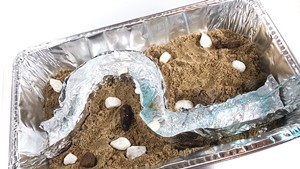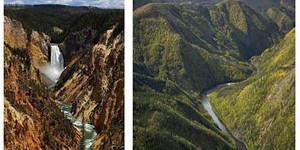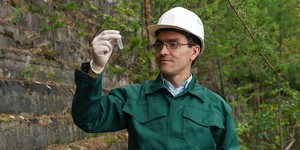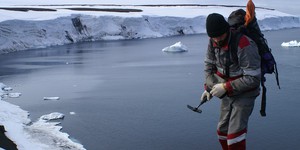Summary
Introduction
Earth is a very watery place! More than 70% of the Earth's surface is covered by water. This is due to the many water bodies that can be found everywhere on our planet. What types of water bodies do you know? They are all very distinct from one another in their appearance, size, shape, and movement. In this activity, you will explore the distinct characteristics of a river by creating a river model inside a pan with sand, pebbles, and real water! After that, you can continue to model other water bodies, too!
Materials
- Aluminum pans or shallow dishes
- Sand
- Pebbles
Note: If you do not have any sand or pebbles, you can substitute these with other materials such as rice, grains, Lego®, or blocks. If you use other materials, make sure they are not able to dissolve in water or float on the water surface. - Water
- Bottle with a narrow opening
- Aluminum foil
- Small bowl for water collection
- Scissors
- Tape
- Nail
- Book or box
- Paper towels
- Optional: Blue food dye
-
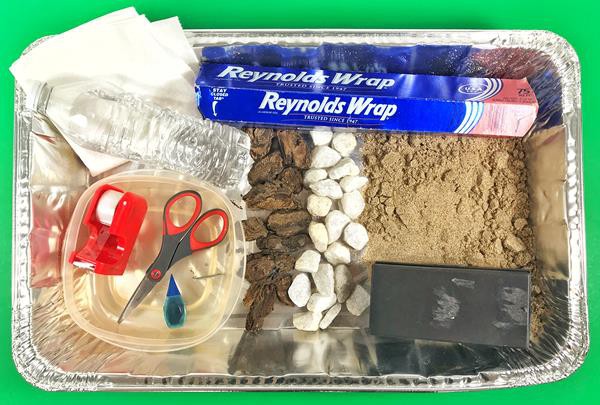 Image Credit: Svenja Lohner, Science Buddies / Science Buddies
Image Credit: Svenja Lohner, Science Buddies / Science Buddies
Prep Work
- Find a workspace that can tolerate water spills.
- Gather all your materials.
- Fill the water bottle with tap water. Optionally, you can add some blue food dye to the water so you can see it better.
Instructions
- Find pictures of different rivers online. Think about these questions while looking at the images.What do all the rivers in the different images have in common? What are the shores of a river like? How much water is in a river? Is it big or small? What is the shape of a river?
- Make a list of things that describe a river.How many things can you come up with?
- Once you have an idea of what characterizes a river, start building your river model inside the aluminum pan. First, fold the aluminum foil so that it resembles a riverbed and place it in the pan. Secure it to the pan with tape.How curvy or straight is your river?
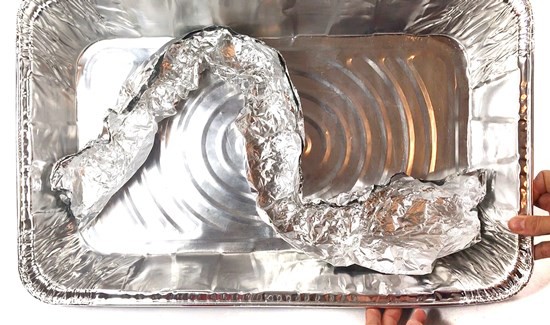 Image Credit: Svenja Lohner, Science Buddies / Science Buddies
Image Credit: Svenja Lohner, Science Buddies / Science Buddies
- Flatten the bottom of the aluminum riverbed with your fingers.Why do you think this is important?
- Then use sand and pebbles or other materials to create the landscape around your river.How does the shore of your river look?
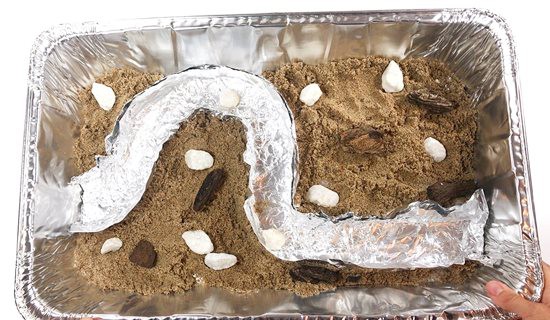 Image Credit: Svenja Lohner, Science Buddies / Science Buddies
Image Credit: Svenja Lohner, Science Buddies / Science Buddies
- When you have finished building, carefully pour the water into your aluminum foil river. Add as much water as you need. Compare your model with an image of a real river.How closely does your model resemble a real river? What is missing in your river model?
- So far, the water in your river model is not moving.How does water move in a real river? Can you replicate this water movement in your model?
- To replicate how water moves in a river, first set up a water collection container at the end of the aluminum pan. Then use a nail to poke a hole into the aluminum pan where your river ends.
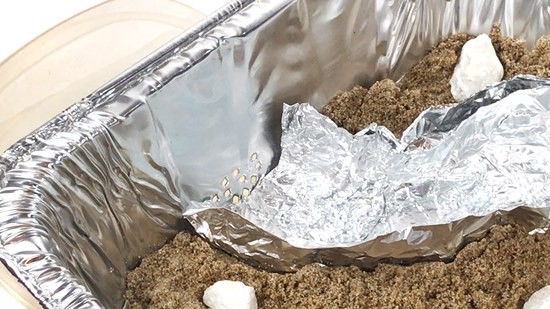 Image Credit: Svenja Lohner, Science Buddies / Science Buddies
Image Credit: Svenja Lohner, Science Buddies / Science Buddies
- Incline the aluminum pan by placing one end on a book or box and drain the river. Then pour more water into the top of the river using a bottle with a narrow opening.How does the water move inside your river as you pour it into your model and where does the water go? Where do real rivers flow to?
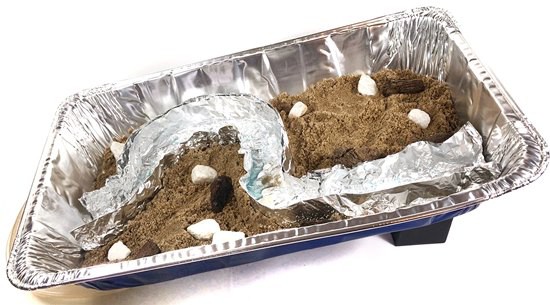 Image Credit: Svenja Lohner, Science Buddies / Science Buddies
Image Credit: Svenja Lohner, Science Buddies / Science Buddies
- Clean out your pan or use a fresh one. Then model another water body such as a lake or an ocean. Repeat all the previous steps and think about how these apply to a lake or an ocean. Again, think about the water movement in these water bodies and try to replicate it in your model.How do these water bodies differ from a river? What changes do you have to make to your river model?
Cleanup
What Happened?
When you built your river, you probably made a long channel from the aluminum foil that was either straight or had several bends. Every river flows inside a channel, which can be narrow or very wide. The channel pattern of a river can be very curvy (also called meandering), braided, or just straight. A river carves its path through the landscape around it. When you built your landscape around the river, it could have resembled anything from steep canyons to flat fields or sandbanks. The soil, sand, or rocks around the river confine the river to its riverbed. When you added water to your model, you probably noticed that it filled up the aluminum river channel and then stayed there. In a real river, however, the water is moving. Once you propped up your aluminum pan and created a slope, you should have observed that the water was traveling downhill along the river channel until it flowed out of the pan and into the collection container. Just like in a real river, the water movement you observed was caused by gravity as the water is moving from a higher elevation to a lower elevation. If you modeled other water bodies such as an ocean or a lake, you might have noticed that they are very different from a river based on their shape, size, or the way their water moves!
Digging Deeper
There is lots of water on our planet! More than 70% of the Earth's surface is covered by water. Any significant accumulation of water on a planet's surface is called a body of water or water body. Water bodies range from huge oceans to tiny ponds, and from large rivers to small streams. The table below lists the different types of water bodies and includes their definitions.
| Type of water body | Definition [based on Wikipedia] |
|---|---|
| Ocean | A major body of salty water that, in totality, covers about 71% of the Earth's surface. |
| Lake | A body of water, usually freshwater, of relatively large size contained inside a body of land. |
| Pond | A body of water smaller than a lake, often of artificial origin. (Note: a pond is similar to a lake but smaller.) |
| River | A natural waterway usually formed by water derived from either precipitation or glacial meltwater, which flows from higher ground to lower ground. |
| Stream | A body of water with a detectable current, confined within a bed and banks. (Note: a stream is similar to a river but smaller.) |
| Puddle | A small accumulation of water on a surface, usually the ground. |
All these water bodies are distinct from one another in various ways. They can hold freshwater or saltwater, vary in size or shape, and have different water dynamics. Rivers, for example, are classified as flowing water, which means that the water inside a river is in constant movement. This movement is due to gravity, as a river always moves downhill from a higher area to a lower area. Rivers are usually confined to a riverbed that looks like a long channel. The shape of the channel can be meandering (very curvy), braided, or straight, as shown in Figure 1.
 Image Credit: Svenja Lohner, Science Buddies / Science Buddies
Image Credit: Svenja Lohner, Science Buddies / Science Buddies
Figure 1. A river channel pattern can be braided (left), straight (middle), or meandering (right)
The place where a river starts is called its source. Many rivers originate in the mountains. They are often fed by groundwater or surface waters such as runoff water, which is water that runs off the land around the river when snow is melting or when it is raining. The river ends at its mouth. This can be an ocean, a lake, or another river. Below is a summary of some typical characteristics of a river, a lake, and an ocean.
| Type of water body | Characteristics |
|---|---|
| Ocean |
|
| Lake |
|
| River |
|
Hydrologists are scientists that study water bodies and their water flow. They often use models in addition to outdoor observations to gather information. Some of these models exist on the computer whereas others are physical replicas of real rivers. Both are great tools to study rivers. This video shows you how scientists at UC Berkeley use a river model for their research.
Ask an Expert
For Further Exploration
- Combine two water bodies in one model. For example, add a lake to your river model which the river can flow into. What changes do you have to make in your model?
- Place materials such as sand or pebbles inside the riverbed and observe how it changes the water flow of the river.
- Rivers can have different channel patterns such as braided, meandering, or straight. Can you make a model of each of these?
- Change the slope of the river by placing one side of the pan onto a higher box. How does the water movement change when the slope of the river becomes steeper?


